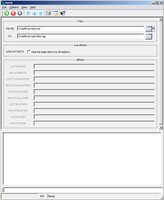This program computes statistics about the HiRISE image and it's
associated ancillary data including the calibration image,
dark reference pixels, and buffer pixels. There are ten sets
of statistics that will be produced using:
- IMAGE_POSTRAMP
- Lines postramp
- The first 30 lines of image data
- IMAGE
- Remaining lines of image data after the postramp.
- If the input image is 30 lines or less, then all statistics will be zero
- IMAGE_DARK
- Image dark reference pixels
- 16 pixels per line
- IMAGE_BUFFER
- Image buffer pixels
- 12 pixels per line
- CAL_REVERSE
- Calibration image reverse lines
- First 20 lines of calibration image
- CAL_MASK
- Calibration masked lines
- From 5 - 20 lines after reverse depending on TDI
- CAL_RAMP
- Calibration ramp
- Remaining lines after masked lines
- CAL_DARK
- Calibration image dark reference pixels
- 16 pixels per line
- CAL_DARK_RAMP
- CAL_BUFFER
- The calibration image buffer pixels
- 12 pixels per line
The following statistics for each data set will be produced:
- Average
- Standard deviation
- Variance
- Minimum
- Maximum
- Total pixels
- Valid pixels
- Null pixels
- Low instrument saturation pixels
- Low representation saturation pixels
- High instrument saturation pixels
- High representation saturation pixels
The statistics will be output to the print file and additionally, if the user specifies, a file using the
TO parameter, the statistics will be written to the file in a standard PVL format which can then be read using
the getkey program. Because the very edges of several parts of the image are
often inaccurate, histat also has the ability to disregard some pixels.
The first and last line of the calibration image is not regarded, nor are the
first and last samples of any line in the calibration image. For this reason,
an image with a calibration image of 62 lines by 512 samples will be broken
down as follows:
Last 19 lines of the reverse readout pixels (all but the first)
All 6 (in this case) lines of the masked pixels
First 33 lines of the ramp pixels (all but the last)
Since the first and last samples of each of these lines is disregarded
automatically, the user is left statistics for the three sections of a
60 line by 510 sample calbration image.
The user is given much more flexibility in excluding samples from the
calibration and dark reference areas of the actual (not calibration)
image. The specific parameters used are described in the "Parameters"
section.
| Jeff Anderson | 2004-06-18 |
Original version
|
| Stuart Sides | 2005-07-06 |
Fixed reporting of special pixels within the HiRISE tables. Special pixels were
not being converted from 16 bit signed word to 32 bit double values before
being sent to the Statistics objects.
|
| Drew Davidson | 2006-01-18 |
Added the ability to use offsets so that edges of the calibration data may
be disregarded.
|
| Drew Davidson | 2006-01-23 |
Seperated calibration image into reverse, masked, and ramp groups.
|
| Drew Davidson | 2006-05-25 |
Changed the default offsets, keywords, and internal offsets, Also added
the CAL_DARK_RAMP group and the IMAGE_POSTRAMP group
|
| Stuart Sides | 2006-10-06 |
Fixed bug where the number of mask lines was calculated. This also
effected the number of ramp lines.
|
| Stuart Sides | 2006-10-06 |
Modified brief and full descriptions of the keywords for ignoring left and
right edges of the different calibration and main image portions of the
observation to eliminate identical descriptions.
|
| Kris Becker | 2007-01-18 |
Merged the changes made by Drew Davidson with the USGS version
to provide single source code management. Changed how the data
is recorded. When a TO file is given output is not written to the terminal
or the log file. If TO is not given, output is written to the terminal and
the log file (default: print.prt).
|
| Steven Lambright | 2008-05-13 |
Removed references to CubeInfo
|
| Kris Becker | 2009-03-13 |
Corrected bug in computation of CAL_DARK_RAMP dataset. It was
hardcoded for handling summing mode 1. It has been corrected to
handle all summing/tdi combinations.
|
| Christopher Austin | 2009-06-09 |
Removed tabs in source code, fixed the example, expanded and structured
documentation.
|




